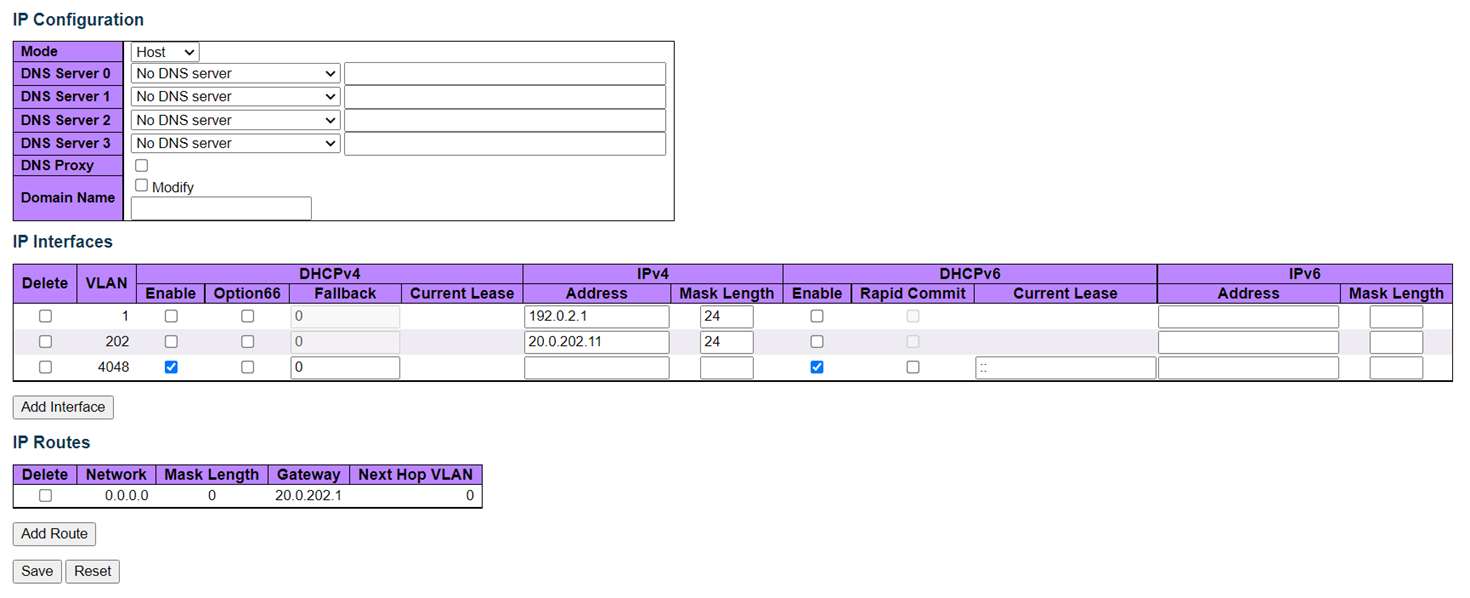| IP Configuration |
| Mode |
Configure whether the IP stack should act as a Host or a Router. In Host mode, IP traffic between interfaces will not be routed. In
Router mode traffic is routed between all interfaces. |
| DNS Server |
This setting controls the DNS name resolution done by the switch. The
following modes are supported:
- From any
DHCP interfaces — The first DNS server
offered from a DHCP lease to a DHCP-enabled interface will be
used.
- No DNS server — No DNS
server will be used.
- Configured — Explicitly
provide the IP address of the DNS Server in dotted decimal
notation.
- From this DHCP
interface — Specify from which DHCP-enabled interface a provided DNS
server should be preferred.
|
| DNS Proxy |
When DNS proxy is enabled, system will relay DNS requests to the currently
configured DNS server, and reply as a DNS resolver to the client devices on
the network. |
| IP Interfaces |
| Delete |
Select this option to delete an existing IP interface. |
| VLAN |
The VLAN associated with the IP interface. Only ports in this VLAN will be
able to access the IP interface. This field is only available for input when
creating a new interface. |
| IPv4 DHCP Enabled |
Enable the DHCP client by checking this box. If this option is enabled, the
system will configure the IPv4 address and mask of the interface using the
DHCP protocol. The DHCP client will announce the configured System Name as
hostname to provide DNS lookup. |
| IPv4 DHCP Fallback Timeout |
The number of seconds for trying to obtain a DHCP lease. After this period
expires, a configured IPv4 address will be used as IPv4 interface address. A
value of zero disables the fallback mechanism, such that DHCP will keep
retrying until a valid lease is obtained. Valid values are 0 – 4294967295
seconds. |
| IPv4 DHCP Current Lease |
For DHCP interfaces with an active lease, this column show the current
interface address, as provided by the DHCP server. |
| IPv4 Address |
The IPv4 address of
the interface in dotted decimal notation.
If DHCP is enabled, this field configures the fallback address.
By default, the DHCP fallback address is 192.0.2.1. |
| IPv4 Mask |
The IPv4 network mask, in number of bits (prefix length). Valid values are
0 – 30 bits for an IPv4 address. If DHCP is enabled, this field configures the fallback address
network mask. The field may be left blank if IPv4 operation on the interface
is not desired, or no DHCP fallback address is desired. |
| IPv6 Address |
The IPv6 address of the interface. An IPv6 address is in 128-bit records
represented as eight fields of up to four hexadecimal digits with a colon
separating each field (:). For example, fe80::215:c5ff:fe03:4dc7.
The symbol :: is a special syntax
that can be used as a shorthand way of representing multiple 16-bit groups
of contiguous zeros; but it can appear only once. It can also represent a
legally valid IPv4 address. For example, ::192.1.2.34.
The field may be left blank if IPv6 operation
on the interface is not desired. |
| IPv6 Mask |
The IPv6 network mask, in number of bits (prefix length). Valid values are
1 – 128 bits for an IPv6 address. The field may be left blank if IPv6
operation on the interface is not desired. |
| IP Routes |
| Delete |
Select this option to delete an existing IP route. |
| Network |
The destination IP network or host address of this route. Valid format is
dotted decimal notation or a valid IPv6 notation. A default route can use
the value 0.0.0.0 or IPv6 :: notation. |
| Mask Length |
The destination IP network or host mask, in number of bits (prefix length).
It defines how much of a network address that must match, in order to
qualify for this route. Valid values are 0 – 32 bits respectively 128 for
IPv6 routes. Only a default route will have a mask length of 0 (as it will
match anything). |
| Gateway |
The IP address of the IP gateway. Valid format is dotted decimal notation
or a valid IPv6 notation. Gateway and Network must be of the same
type. |
| Next Hop VLAN (IPv6 only) |
The VLAN ID (VID) of the specific IPv6 interface associated with the
gateway. The given VID ranges are 1 – 4094 and will be effective only when
the corresponding IPv6 interface is valid. If the IPv6 gateway address is
link-local, it must specify the next hop VLAN for the gateway. If the IPv6
gateway address is not link-local, system ignores the next hop VLAN for the
gateway. |







